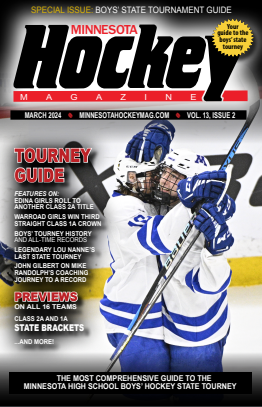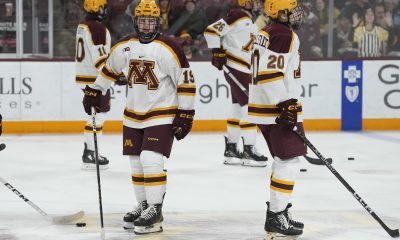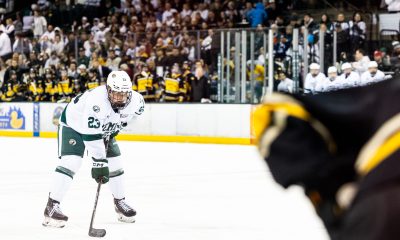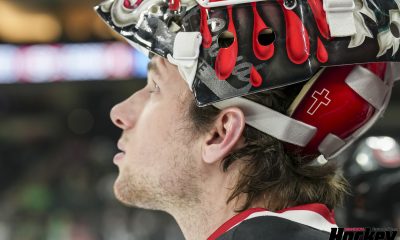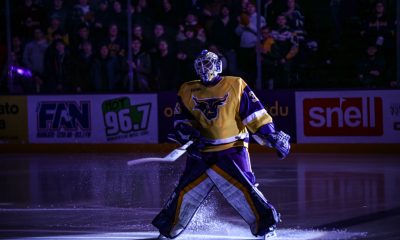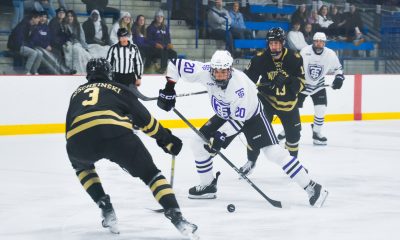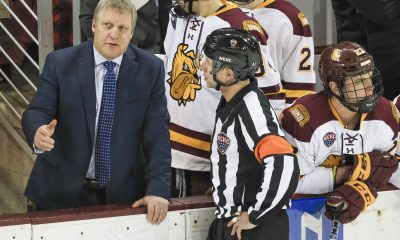College
Flashback: 1st Gophers NCAA Titles
50 years ago, Minnesota was devoid of NCAA hockey titles – until Herb Brooks arrived.
-

by
John Gilbert
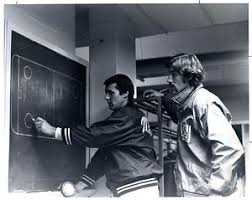
Fifty years ago, the University of Minnesota hockey team was on the verge of ending its season in Madison, where the Gophers had beaten the Badgers 4-3 and then lost 3-0 in the final regular-season WCHA series, which meant they would simply stay at a place called the Edgewater Inn for a two-game, total-goal series against the Badgers two days later.
It was the end of the first season as Gophers head coach Herb Brooks, who had lifted the faltering program from a 10th-place, 7-21 season, to sixth-place with a 12-13-3 record. Minnesota lost 8-6 in the first game of the total-goal set. The team gathered for a group breakfast down a massive winding staircase at the Edgewater, for the obligatory scrambled eggs, bacon, sausage and fried potatoes.
“I remember walking down that art deco staircase,” said Brad Shelstad, a junior goaltender who rode the bench that weekend while Brooks sent Doug Hastings into the nets, despite Shelstad’s better goals-against average and save percentage. “As we were all sitting at our table, there was another group gathered off to one side, and they looked sort of extra casual, with long hair. A couple of our guys made subtle comments about how they looked, but we went ahead with our breakfast.”
The Gophers season ended a few hours later, in a 6-4 playoff loss to finish the 1972-73 season 15-16-3 overall.
“Later on, I checked and found out that the other group in the room was a rock band called Pink Floyd, and they were performing their new album, ‘Dark Side of the Moon,’ in Madison that same weekend,” Shelstad said. “I ended up being a huge Pink Floyd fan, and fan of that album — which I still play all the time.”
That oddity, and that legendary album, might well have gone down as the highlight of Shelstad’s Gophers goaltending career, because there was nothing that spring that foretold what could possibly happen one season later, in the 1973-74 season. Nor could any fans of all the other Minnesota-based college hockey teams appreciate what was coming next.
The University of Minnesota Duluth had just moved up to expand into a Division I program. While St. Cloud State, Mankato State and Bemidji State were all comfortable playing at the Division II level, with reduced scholarship and financial requirements and their own minor-league network. While UMD was striving to reach Minnesota’s stature, the Gophers had never attained proper financial stature with, say, Michigan, which dominated the Big Ten and stood the best chance of competing with the national powers at Denver, North Dakota, Colorado College and the Eastern powers of Boston University, Cornell, RPI and others.
Michigan was the envy of John Mariucci at Minnesota because it enjoyed rivalries with Michigan State, Michigan Tech, Northern Michigan, and later Lake Superior State — five Division I teams compared to Minnesota’s one, or two.
Mariucci stubbornly promoted his homestate high school products, which were trickling out to other schools offering better scholarships. Still, with no junior hockey network to develop prospects up to age 20, Minnesota continued to recruit high school players entering as 18- or 19-year-old freshmen.
Against them, Michigan, Michigan Tech, North Dakota, Denver and Colorado College were all watching Canadian junior players age and develop up to age 20, and those who didn’t get drafted by NHL teams might consider coming to school as 21-year-old freshmen. So, Minnesota’s seniors were sometimes younger than the freshmen brought in post-junior by the other Western college powers.
So, Minnesota had never won an NCAA championship. How could they? When Brooks took over the Gophers program, he was determined to carry on Mariucci’s beliefs and concepts, and while the other in-state college programs considered the Gophers their primary adversary and rival, there was no real indication that something huge was looming on the horizon to attain national championship stature.
In fact, as Shelstad recalled, nothing looked more alluring than “The Dark Side of the Moon” to those young Gophers in 1972-73.
Herb Brooks: The miracle man
In the fall of 1973, the Gophers started 0-4-1, losing to UMD, twice to Wisconsin, tying and losing to Michigan. But then, the Brooks magic set in.
His 23-man roster started to click. Shelstad was No. 1 in goal, with Bill Moen and Eric Lockwood backing up. On defense, Brooks had Brad Morrow, Les Auge, John Perpich, Doug Falls and a giant named Dick Spannbauer. But Brooks wanted more versatility, so he took Joe Micheletti, a young center who had fled Hibbing to the state high school championship, and he converted him to defense. Smart, smooth and good with the puck, Micheletti had an outstanding season. Brooks took a similar path with David Christian on his 1980 Miracle on Ice Olympic team.
Up front, a clever center with a quick shot named John Sheridan was joined by Mike Polich, another Hibbing spark plug, and Tom Vannelli, a crafty center from St. Paul Academy, plus wingers Warren Miller, Buzzy Schneider, John Matschke, Cal Cossalter, Tom Dahlheim, Roseau brothers John and Robby Harris, Edina brothers Bruce and Tim Carlson, Roseville brothers Pat and Mike Phippen. A completely diverse group of forwards — possibly none of whom might have invited notice had they been playing junior hockey, but who all accepted partial scholarships to be a part of the Golden Gophers.
The Gophers gained momentum through the tough WCHA season, although they still had trouble with certain teams. They lost a midseason series at Duluth, split a series with Denver and skated to a pair of ties at Wisconsin. In their final series of the regular season, the Gophers made the trip to Houghton, Mich., where John MacInnes’ Huskies swept the Gophers. That left Minnesota sharing the WCHA championship though still technically second in the conference.
It didn’t matter though, because Minnesota was at home in Williams Arena to two-game, total-goal series against Michigan, which the Gophers swept 5-1 and 5-4. That put the Gophers up against Denver, and the teams tied the first game.
“John Harris backhanded in a big goal for us,” Shelstad said.
Then the Gophers won 2-1 to send them to the NCAA Final Four (as it was known in those days) at Boston Garden.
Gophers reach NCAA Final Four
In the home of the Boston Bruins, the Gophers jumped out ahead of Boston University, but coach Jackie Parker’s Terriersrallied in the third period against Shelstad and the Gophers, closing the deficit to set the stage for the most dramatic single goal in Gophers hockey history.
Having tied the game 4-4, Boston went on the power play when Spannbauer was penalized with a minute to go in regulation. It appeared that the Garden rink was tilted toward Shelstad and the Gophers goal, and it seemed inevitable that the Terriers were going to score again and steal the national championship.
But while killing the penalty through the closing half-minute, Polich stole the puck in the neutral zone and raced into the B0ston zone. Terriars goaltender Ed Walsh, who coincidentally later played with Polich on Montreal’s top farm team where the two were roommates, later told Polich that as he skated in toward the goal, Walsh knew he had an open winger on the far side, and he stole a millisecond glance to see where the winger was. In that instant, when he looked back, he didn’t see any puck.
Polich had cut loose with a quick and deadly shot in that moment, and the puck sailed past Walsh and into the goal for a shorthanded goal to win the game 5-4 with 13 seconds remaining in regulation.
The joy of victory, the great relief at surviving — all the possible emotions — spilled over as the Gophers celebrated. But they still had a huge obstacle awaiting in the defending champion Michigan Tech Huskies.
“We had no options,” said Shelstad. “It was our last game as Gophers. I still remember Bill Steele. I don’t know if he ever went into motivational speaking, but he should have, because he sure motivated me! As we were warming up in Boston Garden, he skated down to our end and came up next to me and said something like, ‘It’s all over now, buddy, because we’re going to fill the net.’ It got to me, and I thought, ‘You little…who do you think you are?’”
The Gophers won its first NCAA championship in Minnesota history by a 4-2 score, outshooting Michigan Tech 39-24.
In the 1975 NCAA championship game a year later, Brooks and his Gophers lost to Michigan Tech. But the teams met again in the 1976 title game in Denver, with the Gophers winning that one. So, after having never won a national title in its history, Minnesota suddenly won two-out-of-three during Brooks’ first three years as head coach.
Brooks put together one more championship team, winning the 1979 NCAA title, to give him three championships in his seven years at Minnesota. That was all before he left to create the 1980 gold-medal-winning Olympic team, loaded Minnesota players.
Now, 50 years later, Minnesota is trying to fight off the challenges from five other Division I programs in Minnesota, with UMD, St. Cloud State, Minnesota State Mankato, Bemidji State and St. Thomas all battling for national prominence. But while gazing into the future, it might be the ideal time to pause for a look back at the proud heritage that Mariucci, Glen Sonmor and Brooks created out of the void of no NCAA titles in Minnesota.





